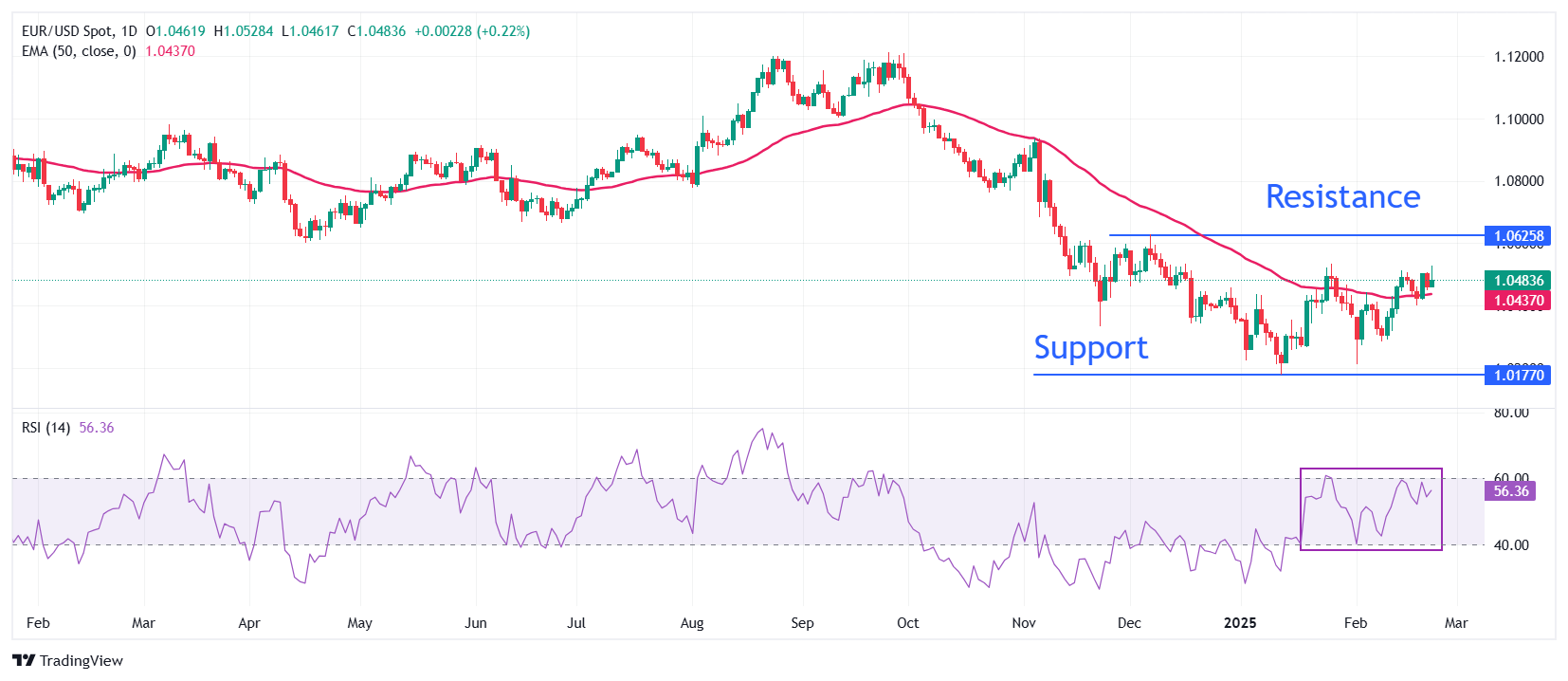- EUR/USD gives up most of its early gains as the US Dollar rebounds.
- Investors are concerned that forming a German coalition government may not boost the economy.
- Soft US private business activity data put pressure on the US Dollar.
EUR/USD retreats from its intraday highs after briefly touching a one-month peak near 1.0530 during Monday’s European session. The currency pair pares significant gains as the Euro (EUR) weakens following the German federal election results, where the absence of a single-party majority raises concerns about economic growth in an already fragile economy.
Christian Democratic Union (CDU) leader Friedrich Merz is set to become Germany’s next Chancellor after securing the majority vote. However, he faces numerous challenges, including complex negotiations to form a coalition government. The most likely scenario points to a CDU-led coalition with the Social Democratic Party of Germany (SPD).
Analysts at ING anticipate that the next German government will provide limited economic benefits beyond a temporary boost from minor tax cuts, modest reforms, and increased investment.
The broader outlook for the Euro remains weak as European Central Bank (ECB) officials continue to advocate for a steady easing cycle. ECB policymaker and Bank of France Governor François Villeroy de Galhau stated in an interview with Alternatives Economiques on Saturday that the central bank could lower its deposit rate to 2% by summer. His comments followed Friday’s release of the Eurozone flash HCOB Purchasing Managers Index (PMI) data for February.
The preliminary PMI report showed that the Eurozone Composite PMI held steady at 50.2, below expectations of 50.5. Additionally, business activity in France contracted at a sharper pace than anticipated.
On Monday, Germany’s IFO data for February largely fell short of expectations. The IFO Business Climate Index, which assesses current conditions and business expectations, remained unchanged at 85.2 from January, missing the forecast of 85.8. In contrast, the IFO Expectations Index, measuring outlook for the next six months, improved to 85.4, exceeding both the estimated 85.2 and the previous reading of 84.3.
Daily Market Movers: EUR/USD Declines as Euro Weakens
- EUR/USD extends its downside move, pressured by a strong rebound in the US Dollar (USD), as investors look past weak US flash S&P Global PMI data for February.
- The US Dollar Index (DXY), which measures the Greenback’s value against six major currencies, recovers to nearly 106.40 after hitting an 11-week low of 106.10 earlier in the day.
- Friday’s US S&P Global PMI report showed that private sector business activity expanded at a slower pace. The Composite PMI, reflecting both manufacturing and services performance, fell to 50.4—its lowest reading since September 2023.
- A sharp downturn in services sector activity was the primary driver of this slowdown. The Services PMI unexpectedly dropped to 49.7 from January’s 52.9, as political uncertainty surrounding federal spending cuts and potential policy shifts weighed on economic growth and inflation outlooks. In contrast, Manufacturing PMI surpassed expectations, rising to 51.6.
- Weak PMI data has fueled dovish bets on the Federal Reserve (Fed), with the probability of a June rate cut increasing to 63.5%, up from nearly 50% a week ago.
- Meanwhile, concerns over a global economic slowdown, driven by US President Donald Trump’s tariff policies, have provided support for the US Dollar. Trump has proposed reciprocal tariffs and levies on key industries, including lumber, semiconductors, pharmaceuticals, and automobiles.
Technical Analysis: EUR/USD retreats from 1.0530
EUR/USD retreats from an intraday high of 1.0530 to near 1.0480 in European trading hours on Monday. The 50-day Exponential Moving Average (EMA) continues to offer support to the major currency pair at around 1.0437.
The 14-day Relative Strength Index (RSI) wobbles around 60.00. A bullish momentum would activate if the RSI (14) sustains above that level.
Looking down, the February 10 low of 1.0285 will act as the major support zone for the pair. Conversely, the December 6 high of 1.0630 will be the key barrier for the Euro bulls.






